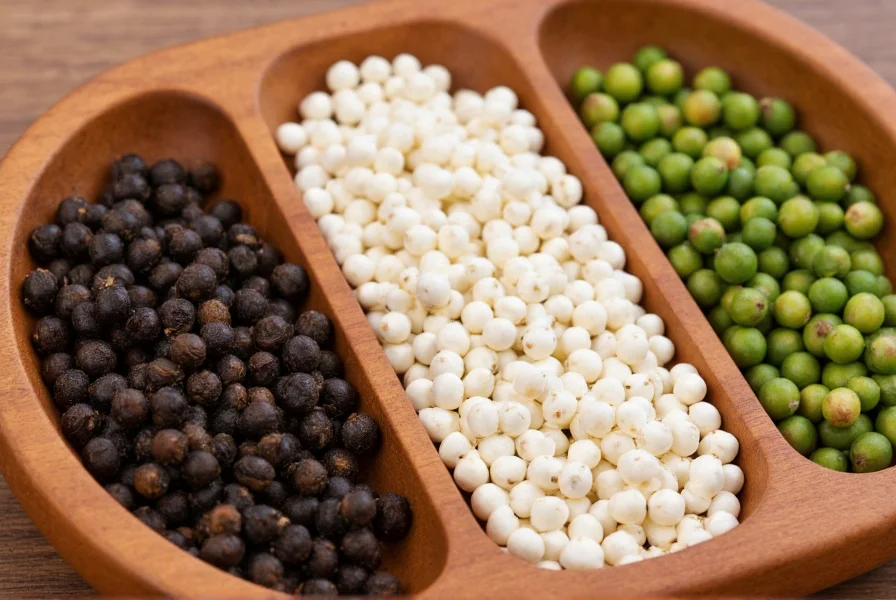Understanding Pepper Varieties
When discussing pepper, it's crucial to distinguish between the two botanical families. Piper nigrum, native to South India, produces the familiar spice pepper available as black, white, and green varieties depending on harvest time and processing. Meanwhile, Capsicum species—including bell peppers and chili peppers—belong to the nightshade family and originated in the Americas. Understanding this distinction helps clarify cooking applications, nutritional content, and growing requirements for different types of pepper for cooking.
Black Pepper: The King of Spices
Black pepper, made from unripe Piper nigrum berries dried until they turn black, contains piperine—the compound responsible for its characteristic heat and numerous health benefits of black pepper. This spice enhances nutrient absorption, particularly of curcumin in turmeric, and provides manganese and vitamin K. Proper storage in airtight containers preserves volatile oils that deliver black pepper's distinctive aroma and flavor.

Bell Peppers: Colorful Nutrition Powerhouses
Bell peppers (also called sweet peppers) come in multiple colors—green, yellow, orange, and red—each indicating different maturity stages and nutrient profiles. Red bell peppers contain nearly 10 times more beta-carotene and twice the vitamin C of green varieties. The nutritional value of bell peppers makes them excellent for raw consumption in salads, roasting, or stuffing. Their mild flavor and crisp texture explain why bell peppers are among the most versatile types of pepper for cooking in global cuisines.
| Pepper Type | Scoville Heat Units | Primary Culinary Use | Key Nutrients |
|---|---|---|---|
| Black Pepper | 100-500 SHU | Seasoning for savory dishes | Manganese, Vitamin K, Piperine |
| Bell Pepper (Red) | 0 SHU | Raw salads, roasting, stuffing | Vitamin C, Beta-carotene, Lycopene |
| Jalapeño | 2,500-8,000 SHU | Salsas, pickling, Mexican cuisine | Vitamin C, Capsaicin, Vitamin B6 |
| Habanero | 100,000-350,000 SHU | Hot sauces, Caribbean dishes | Vitamin C, Capsaicin, Vitamin A |
Culinary Applications and Pairing Suggestions
Mastering how to use pepper in recipes elevates everyday cooking. Black pepper works best when freshly ground to release volatile oils—add toward the end of cooking to preserve flavor. For bell peppers, green varieties provide crisp bitterness ideal for stir-fries, while sweeter red and yellow peppers shine in roasted vegetable medleys. When growing peppers at home, remember that chili peppers require more sun and warmth than bell peppers, and all pepper plants benefit from consistent moisture without waterlogging.
Health Benefits Backed by Research
Scientific studies confirm multiple health benefits of black pepper, including enhanced nutrient bioavailability, antioxidant properties, and potential anti-inflammatory effects. Bell peppers contribute significantly to daily vitamin requirements—just one medium red bell pepper provides 169% of the recommended daily vitamin C intake. The capsaicin in hot peppers may boost metabolism and provide pain relief when used appropriately. Incorporating various pepper types into your diet supports overall nutritional diversity.
Growing Peppers Successfully
Whether you're growing peppers at home in containers or garden beds, these plants require well-draining soil with pH 6.0-6.8, consistent watering, and 6-8 hours of daily sunlight. Start seeds indoors 8-10 weeks before last frost date. For best results with chili peppers, maintain temperatures between 70-85°F (21-29°C). Harvest bell peppers when they reach full size and develop their characteristic color; pick chili peppers when they achieve desired heat level. Properly stored peppers can last 1-2 weeks in the refrigerator or be frozen for longer preservation.
Frequently Asked Questions
What's the difference between black pepper and bell pepper?
Black pepper comes from the Piper nigrum plant and is used as a spice, while bell peppers are fruits from Capsicum plants. They belong to different plant families, have distinct flavors (pungent vs. sweet), and serve different culinary purposes. Black pepper contains piperine for heat, while bell peppers contain capsaicinoids in varying amounts depending on variety.
Which pepper has the highest nutritional value?
Red bell peppers generally offer the highest nutritional value among common peppers, containing nearly 10 times more beta-carotene and twice the vitamin C of green bell peppers. Black pepper provides significant manganese and enhances absorption of other nutrients. For maximum nutritional benefit, include a variety of pepper types in your diet to access their complementary nutrient profiles.
How should I store different types of peppers?
Store whole black peppercorns in an airtight container away from light and moisture—they'll maintain potency for 1-2 years. Ground pepper loses flavor more quickly (3-6 months). Bell peppers should be kept in the refrigerator's crisper drawer in a plastic bag for 1-2 weeks. Hot chili peppers can be frozen whole for up to 6 months. For optimal flavor preservation, always store peppers away from heat sources and direct sunlight.
Can you grow peppers indoors successfully?
Yes, many pepper varieties can be grown indoors with proper conditions. Choose compact varieties like 'Lunchbox' peppers for bell peppers or 'Thai Hot' for chilies. Provide 14-16 hours of full-spectrum lighting daily, maintain temperatures between 70-85°F (21-29°C), and ensure good air circulation. Use well-draining potting mix in containers with drainage holes, and water when the top inch of soil feels dry. Indoor pepper plants typically yield smaller crops but can produce year-round with proper care.










 浙公网安备
33010002000092号
浙公网安备
33010002000092号 浙B2-20120091-4
浙B2-20120091-4